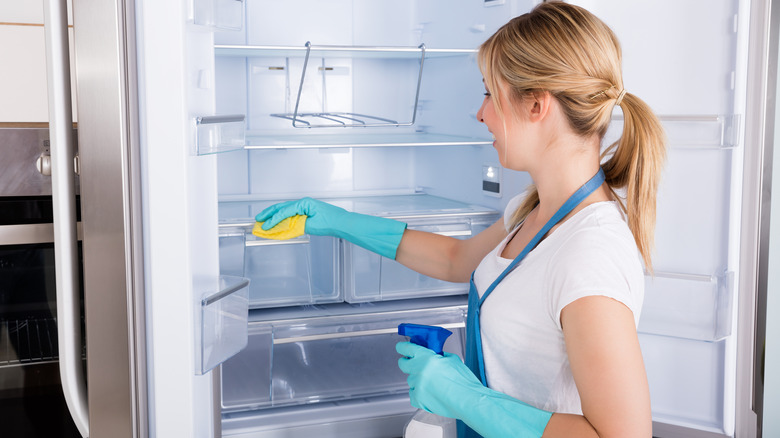What To Do If You Find Mold In Your Fridge
When scanning your refrigerator for something green to add to the dinner table, you're likely looking to grab some spinach, avocados, or broccoli — not mold. Unfortunately, due to their consistent darkness, minimal air flow, and regular moisture, refrigerators provide the perfect breeding ground for menacing microbes that range in color from green and white to pink and black. If you find one or all of these fuzzy colored molds growing on the shelves or walls of your refrigerator, it's time to eliminate the source and execute a deep clean.
Life happens. You were in the midst of the morning rush and didn't have time to wipe up the milk that dripped into the crisper drawer or the red liquid leaking from the container of strawberries. Now your gross mess has spawned a family of mold thriving on the interior spaces of your appliance. Don't panic. It is very common for mold spores cultivated on spoiled food to disperse throughout a refrigerator via the ventilation system and transfer to hard surfaces.
Fridge fungus doesn't pose an imminent threat to your family's health. But according to the CDC, if left untreated, mold can exacerbate symptoms in those with respiratory issues such as asthma or allergies. The good news is that there are easy and affordable ways to eradicate mold from your refrigerator by using everyday household staples that are safe for your family and the environment.
How to eliminate mold from your fridge
The first step to restoring your fridge to its original mold-free shine is to remove everything from it. Completely strip your refrigerator of its contents, including food, beverages, and storage containers. Additionally, remove all of the appliance's racks, drawers, bins, and trays, as they will be easier to sanitize in an area where you have full access to them. Next, fill a spray bottle with white vinegar and liberally spritz the interior of the refrigerator, paying close attention to areas with visible mold. Once you vigorously scrub the fridge's interior from top to bottom with a soft cloth, follow up by wiping with a clean damp rag, then finish by drying all surfaces with an absorbent towel.
If you have a sensitivity to the pungent smell of vinegar, dilute ½ a cup of vinegar with 1½ cups of water in a spray bottle; however, prior to applying it, scrub moldy areas with dish soap and warm water. Allow the vinegar solution to sit on the interior spaces for about 10 minutes before rinsing with a damp cloth. Alternatively, you can combine 1 tablespoon of baking soda with 1 quart of warm water in a bucket, soak a rag in the solution, and thoroughly scrub all surfaces. Repeat the cleaning process on all drawers, shelves, and other accessories you removed from the refrigerator, including all non-porous food containers. Finally, inspect all non-packaged food items for mold prior to placing them back in the fridge.
Tips for preventing mold growth in your fridge
If you are wondering how often you need to clean your refrigerator to prevent mold growth, the answer is regularly. Complete a deep clean every three to four months, but don't wait until then to wipe up sticky spots from jelly jars or ketchup bottles. Tackle spills and drips immediately to reduce the chances of them fostering mold growth. In addition, each week, examine the food in your fridge. Review expiration dates on all packaged items and take a good look, and even better whiff, of items stored in and out of containers. If you notice even the slightest signs of rotting, trash them right away.
Given that mold loves moisture, it's critical to reduce as much dampness inside your refrigerator as possible. This means mopping up any residual water or condensation. If you have a habit of washing produce prior to storing it in a crisper, be sure to dry it completely first, as the smallest amount of moisture can accelerate mold growth in a refrigerator's dark environment. Likewise, don't ignore the rubber seals that run along the perimeter of the appliance's door. You may notice orange mold accumulating in the seals' crevices due to moisture that forms when the doors are constantly opened and closed. These unsightly microbes can be scrubbed off with the aforementioned vinegar or baking soda solutions and wiped dry with a clean cloth on a daily basis to create an uninviting spot for mold to return.


